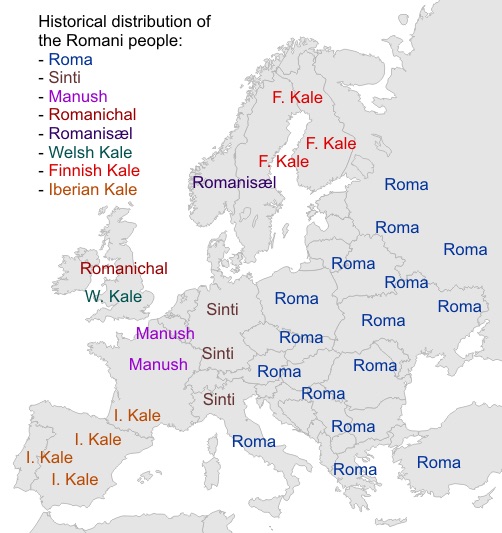The Romani: from India to the World Posted by Rachael on Feb 3, 2019 in Hindi Language
Almost everyone has heard the term “gypsy,” but very few know of these people’s origin (मूल/mool), culture (संस्कृति/sanskriti), religion (धर्म/dharm) and language (भाषा/bhaashaa). Indeed, you may be surprised to learn that the origin story of these resilient and resourceful people is inextricably connected to what is now India and the Indian diaspora. Known most often by the names Romani (or Romany), Rom (meaning “man/आदमी” or “husband/पति” in the Romani language) and Roma, these groups of traditionally nomadic people originally traveled to the Balkans and surrounding areas from the Northwestern region (उत्तर-पश्चिमी क्षेत्र/uttar pashchimi kshetra) of the Indian subcontinent (उपमहाद्वीप/upmahaadveep), from what is today Rajasthan, Haryana and Punjab, roughly 1,500 years ago. It is thought that the impetus for their migration (प्रवास/pravaas) came in the form of defeat (हार/haar) at the hands of Mahmud of Ghazni during his numerous raids of the northwest, which resulted in looting and destruction. Defeat was usually followed by a transfer of power to local vassals who were nevertheless loyal (वफ़ादार/vafaadaar) to this ruler. Soldiers who had fought on the opposing sides may have chosen to move westward with their families toward the regions once claimed by the Byzantine Empire, starting in the 500s AD. Thus began the pivotal exodus of the Romani people, which came to define their history, culture and way of life for centuries to come.
“Gypsy,” the name for these groups of people with which most are familiar, is actually an exonym or an external name imposed from without by others as opposed to an endonym, which is a name a group of people develop for and by themselves. Today, many consider this term to be derogatory (अनादरपूर्ण/anaadarpoorn, lit. lacking respect) due to its implications of being outside the “norms” (रीति-रिवाज़/reeti-rivaaz or customs) of traditional society (पारंपरिक समाज/paaramparik samaaj) (in which most people reside in a place permanently and practice an established trade rather than living and working nomadically, ख़ानाबदोश/khaanaabadosh=nomad, lit. carrying one’s home on one’s back). Although some Romani people have adopted the term “gypsy” to refer to themselves due in part to its convenience and accessibility, it is important to note that this term has a history of vicious prejudice and stereotypical inaccuracy – as proof of this point, the English term “gypsy” derives from the Greek and Latin words for “Egyptian” due to the erroneous but widespread belief in the Middle Ages that the Romani hailed from Egypt.
The Romani began the long trek (यात्रा/yaatraa or सफ़र/safar) from the Indian subcontinent many centuries (सदी/sadi) ago but arrived in midwestern Asia and Europe about 1,000 years ago. It is thought that there were, in fact, two groups (समूह/samooh) that made this westward journey – the Romani and the Dom people. These communities (समुदाय/samudaay) originally shared much of their culture, history (इतिहास/itihaas) and language but, due to successive waves of migration, were eventually separated from one another. Another idea in support of this concept of separation via successive migrations over centuries is that the Romani and Domari languages evolved distinctly to the point that they are considered two different languages today. In modern-day North India, it is possible that certain scheduled castes and tribes (sing: अनुसूचित जाति और जनजाति/anusoochit jaati aur janjaati), such as the डोम caste known for working as traveling dancers and musicians, could indeed be genetically related to the Romani people who left India centuries ago. Today, the many groupings of the Romani people and their differing religions and languages are influenced not only by their differing countries of residence but by the legacy of the Hindu caste system and its numerous intra- and inter-group distinctions, which the Romani carry with them still.
Interestingly, the Romani usually did not keep written (लिखित/likhit or लिखा हुआ/likhaa huaa) or oral accounts (मौखिक विवरण/maukhik vivaran) of their history, and thus much of their history has been reconstructed via linguistics and genetics. That is to say, through studying the Romani language and its variants, linguists discovered that it possesses numerous similarities with other Indo-Aryan languages. For example, most of the basic vocabulary (शब्दावली/shabdaavali) for parts of the body (शरीर के अंग/sharir ke ang) and routine processes in the Romani language closely aligns with parallel vocabulary in Hindi and Punjabi, while Romani grammar (व्याकरण/vyaakaran) is similar to that of Bengali and some of its phonetic features are akin to those in Marwari. Due to the large dispersal of the Romani, who reside in about 30 countries around the world today, their language has similarly splintered into numerous dialects (sing: बोली/boli, plural: बोलियाँ/boliyaan) that take on some of the vocabulary of the local languages with which they find themselves surrounded. In part due to their intermarriage with local people and the entrenched discrimination they often face, the Romani often do not categorize themselves as such on official censuses, which makes it difficult to estimate exactly how many Romani there are worldwide.
Today, the Romani reside mostly in Egypt, the United States, Europe (especially central, eastern and southern Europe such as Turkey, Spain and Southern France) and Brazil. The Romani began to immigrate (आप्रवास करना/aapravaas karnaa) to the United States in large numbers in the 1860s and early 1900s, although the US government (सरकार/sarkaar) attempted to bar their immigration beginning (formally) in 1885. As for Brazil, most Romani immigrated to this country (देश/desh) in the 19th century from Eastern Europe (पूर्वी यूरोप/poorvi Europe), but some Brazilian Romani are descendants (वंशज/vanshaj) of groups of people deported from the Portuguese Empire during the Portuguese Inquisition beginning in 1536. Despite their numerous travels around the world, some recognize the Romani as important members of the Indian diaspora; in fact, during the International Roma Conference in 2016, the Indian Minister of External Affairs recommended that the government of India recognize them as such, although this recognition has yet to be formalized.

Build vocabulary, practice pronunciation, and more with Transparent Language Online. Available anytime, anywhere, on any device.







Comments:
Kurt Hahn:
Most fascinating topic, one which has occupied my thinking for some time, since my Macedonian friends have told me of similarities of their language with Hindi.
Rachael:
@Kurt Hahn Hi Kurt! Yes, it is quite an interesting topic – glad you enjoyed the blog! 🙂